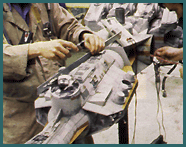SPECTACULAR CLIMAX
The Rebel attack sequence that ends the film is centered around the destruction of an incomplete Death Star. The Alliance is attempting to fly to the reactor chamber and knock out the huge reactor that powers the Star. To get there the good guys must travel down a series of shape-changing tunnels with the bad guys hot on their tails. Once they blow up the reactor then they must race out a ball of fire behind them and the enemy in front of them. There are moments in the sequence when there are 30 to 40 ships on screen. Many of the ships are artistic looking pieces of debris and an occasional piece of chewing gum.
The sequence required over 360 feet of tunnels. Each tunnel was three feet by four feet by 72 feet. The walls were made of mirrored plexiglas and each foot-long section of the ceiling came off as the camera flew down the corridor to really give the illusion of a closed space. Steve Gawley described the materials:
"We used some pretty funny things. We used cardboard tubes that are used for holding rolls of carpet. I think we used 5 or 6 miles of it. We used sprinkler pipe for the smaller pipe and I think we used 2 or 3 miles of that. the illusion in the tunnels is supposed to be one of girders and pipes and all sorts of machine-like shapes. We had to make a lot of that stuff. the girders were made out of wood, we just made a lot of kite-stick-size cuts of wood that had Lincoln log-like joints."
"It is pretty fantastic flying down that tunnel. It ends up in this big room called the reactor chamber, and the effect is like you're flying down this tunnel and suddenly, on the other end of it is the Grand Canyon." The reactor chamber was a table-top model 20 feet in diameter. Gawley continued, "It's about 5 feet tall in the center and the detail is in pie shapes. We made one pie-shaped pattern and then we farmed it out to a local foam fabricator. He took this one pattern and repeated it 50 times. The perimeter of it was mirrored plexiglas with etched brass glued on the sides. We scratched holes in the plex to let light bleed through to help with the scale.
"The lights we used were those GE light sticks that stick underneath a shelf. We used about 500 of those suckers in all the sets to give it a consistent look. "It's all-round going to be great. People will have to go see it just for the visuals, " Gawley concluded.
The model shop crew is an integral part of the magic spell conjured up in Return of The Jedi. They provide new wings and new worlds for the imagination to explore. As Steve Gawley said, "It's fantastic! Do I use that word too much?"
